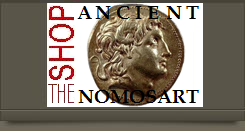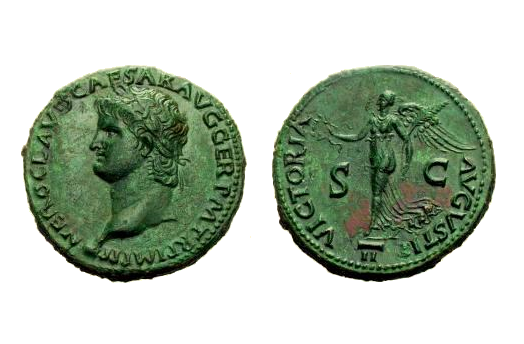
about ancient nomos
Ancient Nomos Art is a museum of galleries exhibiting ancient coins and ancient mint maps. The coin gallery displays the diverse art and history of hand-crafted ancient Greek, Roman, Byzantine, Persian and Medieval coinage. The ancient mints mapping gallery features Greek, Roman, Byzantine, Asia Minor and Medieval mint city regions and territories. Visitor's are welcome to explore, study and enjoy Ancient Nomos Art.

Roman Imperial – 65 AD
Nero
From Ancient Galleries

Obverse: Laureate bust of Nero facing left with small globe at chest in legend.
Reverse: Goddess Victory advancing left, holding wreath and palm branch.
LEGEND
Obv: NERO CLAVD CAESAR AVG GER P M TR P IMP P P, Laureate Nero bust facing left, globe at point of bust. Rev: VICTORIA AVGVSTI, Victory advancing left, holding wreath and palm-branch; II denomination (dupondius) value in exergue, S C (Senate Consulto) across the field.
Emperor Nero was born December 37 AD to Cornelius Ahenobarbus and Agrippina, great-granddaughter of Emperor Augustus. After Ahenobarbus’ death, Agrippina married Emperor Claudius who later adopted Nero in 50 AD. He ascended in 54 AD after his mother poisoned Claudius. By 59 AD Nero established a ruthless reign, killing his mother, brother, wife, nobleman, senators, Christian’s and Jews. This coin was issued ten years into his reign, evident by the official title encircling a realistic and artfully stylized bust of Nero. He is seen with a large neck, protruding chin, smirking lips, deep-set eyes, and wearing a laurel wreath. Most notable features, not typical to Emperor portraits, are the stylized rows of his evenly curled hairs below the laurel wreath and his long flowing locks of curled hair brushed awkwardly forward behind the neck. Nero’s head is also tilting back from the neck to affect grandeur and give a sense of confidence, while his visual adiposity and sinister jowls exude malevolence. Lugdunum is the minting place for this coin and is noted by a small globe-like mintmark appearing at the end of Nero’s chest (Sutherland 1974). The reverse depicts the goddess Victory with her wings open as she strides gracefully to the left. Her body is three quarter facing, wistfully gliding on toes, as her gown drapery blows back in curls from the breeze behind her advancing right leg. Her two symbols are the victorious wreath, held in her out stretched right hand, and the palm branch flexing back in the wind, held securely in her relaxed left arm. Nero likely decided to associate himself with Victory to commemorate the recently forged peaceful alliances between Rome and the eastern provinces, including Parthia. Victory may also reflect Nero’s political propaganda, believing the image might elevate his stature at a time when popularity was in rapid decline.
DOCUMENTATION
Value: Dupondius. Metal: Æ Bronze. Weight: 14.07 grams. Mint: Lugdunum. Date: circa 65 AD.
Attribution: Roman Imperial Coinage I, 412; WCN 509; BMCRE 351; H.D. Rauch 76, 484.
Legend, Documentation and Attribution
